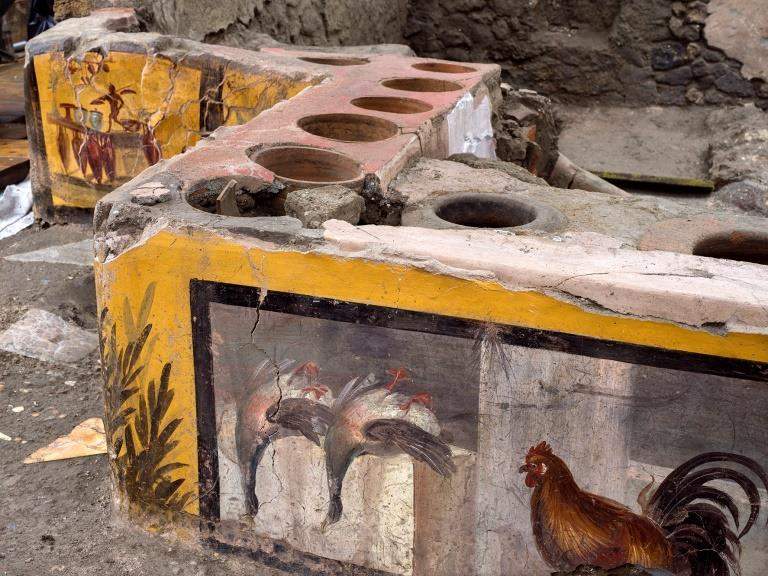In Pompeii, work on the frescoes of the thermopolis, the ancient city’s “diner,” which resurfaced in March 2019, is nearing completion: last year the commercial structure had been only partially investigated as part of the Great Pompeii Project’s interventions to secure and consolidate the historic excavation fronts, but the work, given the importance of the room and its decorations, went ahead with the aim of bringing to the surface the entire configuration of the room. Thermopoli, rooms in which drinks and hot food were served stored in large dolia (jars) embedded in the masonry countertop, were widespread in the Roman world, where it was customary to consume the prandium (meal) outside the home. In Pompeii alone there are about 80 of them. The one just investigated is located at the intersection of Silver Wedding alley and Balcony alley. The excavation has thus been completed and the results were announced today.
Of great value, in particular, are the decorations on the counter, the first to emerge from the excavation, which feature on the front the image of a Nereid, or a sea nymph, on horseback, and on the short side the illustration of the store itself, in the manner of a commercial sign: these are the decorations that had already been made known last year. During the new excavation phase, more decorations emerged on the last counter arm brought to light: these are still life scenes and representations of animals, which were probably slaughtered and sold on the premises. Bone fragments, pertaining to the same animals, were also found inside vessels carved into the thickness of the counter containing food for sale. Decorations show, for example, two ducks displayed upside down, ready to be prepared and consumed, a rooster and a dog on a leash. A graffitied inscription was also found that reads Nicia cineadecacator on the frame enclosing the depiction of the dog, which addresses a certain Nicia calling him an “inverted shitter” (thought to be a joke played on someone who worked in the thermopolis).
Initial analysis, says anthropologist Valeria Amoretti, who worked on the excavation, confirms that the paintings on the counter represent, at least in part, the food and drink actually sold inside the thermopolis: two ducks are depicted among the paintings on the counter, and indeed a duck bone fragment was found inside one of the containers, along with pig, goat, fish and land snails, testifying to the wide variety of animal products used in the preparation of the dishes. Initial archaeobotanical analysis identified fragments of deciduous oak, probably pertaining to structural elements of the counter. On the bottom of a dolio (identified as a wine container on the basis of the drawing bottle found inside it) were fava beans, intentionally fragmented/milled. The cook Apicius, in his treatise De re Coquinaria (I,5) gives us the reason for this, asserting that they were used to change the taste and color of wine by bleaching it.
Human bones of victims of the eruption of Vesuvius have also been found at the site, probably upset by the clandestine diggers who frequented the site in centuries past. A complete dog skeleton, 20-25 centimeters tall at the shoulder, was also found in the corner between the two gates (a not-so-frequent occurrence since the Romans preferred larger dogs, but were able to select even small dogs). Then again, pantry and transport materials were found: these consisted of nine amphorae, a bronze patera, two flasks, and a common tableware pottery olla. The floor level of the entire room consists of a layer of cocciopesto (an impermeable coating composed of terracotta fragments), into which fragments of polychrome marbles (alabaster, holyware, green breccia and bardiglio) were inserted in some places.
“With a team effort, which required legislative regulations and quality of people,” says Minister of Cultural Heritage Dario Franceschini, “today Pompeii is referred to around the world as an example of protection and management, returning to being one of the most visited places in Italy where research is done, excavation continues and extraordinary discoveries such as this are made.”
“In addition to being further evidence of daily life in Pompeii,” explains Massimo Osanna, acting director general of the Pompeii Archaeological Park, “the possibilities for analysis of this thermopolis are exceptional, because for the first time such an environment was excavated in its entirety and it was possible to conduct all the analyses that today’s technologies allow. The materials found were, in fact, excavated and studied in every aspect by an interdisciplinary team consisting of: physical anthropologist, archaeologist, archaeobotanist, archaeozoologist, geologist, and volcanologist. The materials will be further analyzed in the laboratory and in particular the remains found in the dolia (earthenware containers) of the counter, will represent exceptional data to understand what was sold and what the food diet was.”
 |
| Pompeii, this is what an ancient bar looked like. Excavation of thermopolis discovered in 2019 finished |
Warning: the translation into English of the original Italian article was created using automatic tools. We undertake to review all articles, but we do not guarantee the total absence of inaccuracies in the translation due to the program. You can find the original by clicking on the ITA button. If you find any mistake,please contact us.